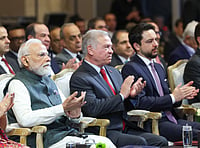A quiet revolution is taking place in Indian business. Corporates, public sector undertakings, banks and financial institutions are waking up to the axiom of doing business in the 1990s—the race belongs not to the biggest but to the better and faster informed. Suddenly, computer networking is big business.
After tottering around to find its feet for the past several years, networking is one of the fastest growing markets in India today. Sales of networking products grew by nearly 200 per cent last year to touch a market size of around Rs 300 crore to Rs 350 crore, says Vineet Nayar, president, HCL Comnet, a leading systems integrator for networking technology.
That networking majors look upon India as an attractive market is evident from the sudden torrent of global industry leaders like Cisco Systems, 3Com, Bay Networks International, Cabletron and UB Networks. Cisco Systems, the world's largest networking company, plans to set up a subsidiary in India in the next three to four months, discloses Anil Batra, the company's country manager for India and the SAARC region. So important is the Indian market that sometimes Cisco's new networking products are first introduced in India and then the rest of the world, Batra adds.
Says Subash Bal, CEO of 3Com's India operations: "The networking market will grow by over 100 per cent in the next couple of years to reach total sales of up to Rs 1,000 crore." Adds Batra: "The market will continue to grow till well past 2000 AD; it will not reach a saturation point for at least the next 10 years." Considering its high projected growth path, nearly thrice that of the information technology industry as a whole, it won't be long before the networking market's sales equal that of the computer hardware industry, predicts Nayar.
What are the most tangible benefits of networking? Linking employees, managers, departments and businesses in an organisation helps in easy and immediate access to information, reduces the decision-making cycle time and thus facilitates faster responses to business opportunities and threats. The faster a company gets information through Local Area Networks (LANs—computers linked within an office) and Wide Area Networks (WANs—which hook the entire corporation's LANs across the country or, quite often now, across the planet), the sharper is its competitive edge. Indeed, information available on tap, online to executives does far more than just increase efficiency. It transforms the very way a corporation works.
Of course, the sudden boom in the networking business raises one obvious question: did Indian firms wake up only as late as last year to the competitive advantage that networking gives? What were they doing till then? Networking had been clearly recognised as the way of the future several years ago in the West. But, as Nayar explains, the answer may be found in the earlier absence of major players, integrated packages and infrastructure (read telecommunication, satellite and wireless communications) for setting up WANs. For instance, Cisco Systems came to India only in January last year, followed by 3Com, the world's second largest networking company, in May 1995. Bay Networks, reckoned as the third largest globally, arrived here in November 1994.
ANOTHER major reason for the slow start to networking may be the low installed base of personal computers in Indian corporates. As Bal points out, the trend the world over has been for the networking industry to develop only after the installed base of PCs reaches a critical mass. "With the installed base of PCs in India now in excess of one million, it's time for networking to take off," he feels.
Giving a big push to the networking market is the example set by transnational corporations (TNCs), and of course, the arrival in India of the Internet, the most spectacular example of global computer networking. Says Nayar: "New TNCs coming to India have brought in their culture of integrated information systems, their way of doing business being systems and information-oriented. This has posed a competitive threat to Indian industry."
Bal adds that Indian corporates have realised that the unparalleled access to information that networking provides is important to compete with not only TNCs but also domestic companies. Though TNCs may have provided a start-up to the networking industry, it is Indian companies that are now hooked on to the idea of networking in the new environment of globalisation, notes Batra. These Indian businesses are now the drivers of the net-working market in the country.
Earlier, mostly large companies spurred the networking market. But now medium-sized companies, too, have been bitten by the networking bug. In the next two to three years, medium-sized firms are expected to go in increasingly for networking, according to Bal.
Companies like 3Com and Cisco have even started targeting smaller organisations and the small office, home office (SOHO) segment, as well as schools, colleges and universities, banking on the age-old marketing maxim that volumes drive business. For instance, 3Com's Office Connect family of products promises economic networking in outfits with a minimum number of two PCs, stretching to a maximum of 20 units. For Rs 50,000, the company offers a hub (which forms the base of the network) and up to 20 adapters, which is quite affordable, says Bal. Other add-ons like print server, fax server or router for long distance communication or for connection to the Internet, will naturally cost more.
In December last year, Cisco launched a new range of low-cost networking products, under the CiscoPro brandname, designed specifically for branch offices and smaller businesses, offering Inter-net access and solutions for business applications such as telecom-muting, distributed databases and high-speed document transfer. Two months later, in February this year, the company announced the addition of 17 new models to the range. The new products—referred to as plug-and-play networking products—incorporate features, packaging and pricing appropriate for smaller organisations.
Bal expects small organisations to 'get comfortable' with networking within the next six months to a year, in which case the market could grow by more than the projected 100 per cent. Adds he: "If customs duties on networking products are reduced—currently among the world's highest at 65-70 per cent—then only the sky is the limit."
But with only an estimated 30 per cent of computers linked to networks, in both the public and private sectors, India has a lot of catching up to do, feels Bal. Compare this to countries like China, Japan, Malaysia, Taiwan and other Asian tigers, where more than 50 per cent of computers are networked. China has been leapfrogging into the networking arena for the last three to four years, whereas in India, the long hurdle race has only just begun. But begun it has, and is already gathering speed.

























